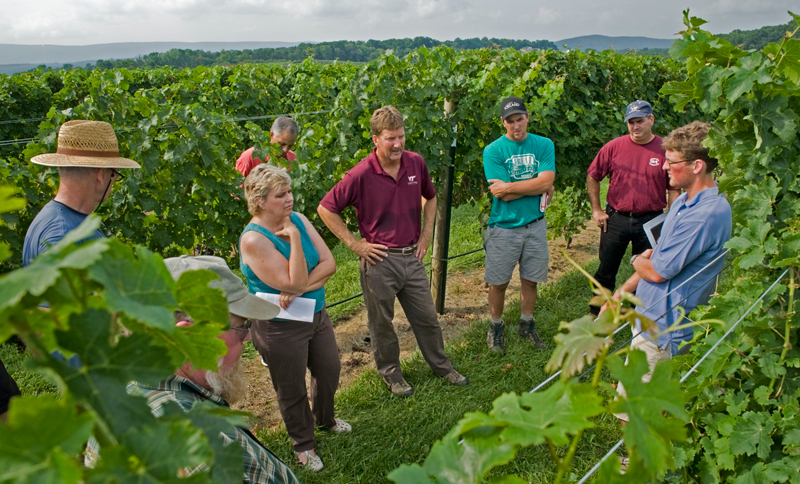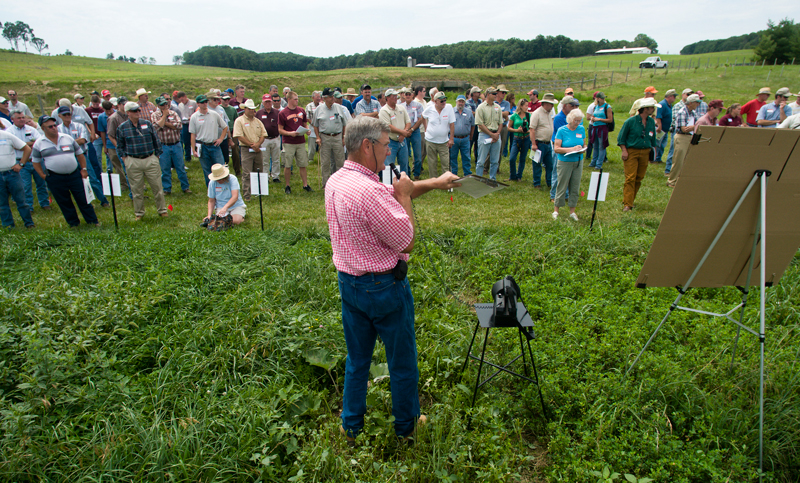For more than a century, Virginia Tech's Agricultural Research and Extension Centers (ARECs) have provided Virginia Tech faculty, staff, and students with the unique ability to perform basic and applied research on issues related to the state's agricultural, seafood, and forestry industries. In addition to serving Virginia's needs, the research conducted at ARECs benefits these industries across the region, the nation, and the world. Twelve ARECs, strategically located across the commonwealth, provide laboratory space, land, and facilities for research programs that reflect each region's agricultural diversity.
The centers were established in part through the creation of the Virginia Agricultural Experiment Station (VAES). In 1886, the Virginia General Assembly established the VAES to conduct research and development programs on behalf of farmers. Then, the Hatch Act of 1887 authorized federal funds for each state to establish an agricultural experiment station in cooperation with the state's land-grant institution. To share information developed from research at the experiment stations, the Smith-Lever Act of 1914 created the Cooperative Extension Service. The first research center in Virginia was established in Appomattox in 1906 to conduct research on dark fire-cured tobacco and other crops.
|
|
|
|
|
 |
|
|
|
|
|
|
 |
|
Go to www.vaes.vt.edu/arecs/index.html to use an interactive map of the state's ARECs, print a map, or download each center's fact sheet, which lists current research, recent impacts, statistics about the center, and faculty and graduate research. |
|
|
|
|
|
|
|
|
|
|
|
|
|
|
|
|
Today, the research projects and activities of VAES encompass the work of approximately 340 scientists and specialists in four Tech colleges: agriculture and life sciences, natural resources and environment, liberal arts and human sciences, and veterinary medicine. In 2009, the National Science Foundation ranked Virginia Tech fifth in the country for agricultural research expenditures, much of which originated through VAES.
Although faculty members use facilities at Tech's main campus in Blacksburg for much of their work, the ARECs offer the opportunity to expand laboratory results into field-scale investigations and to conduct proof-of-concept studies before implementing new ideas and technologies. The work of VAES scientists has had a significant effect on agricultural and forest products, horticulture, human nutrition and food safety, and environmental quality. Here are a few examples of recent AREC successes.
INCREASING PROFITABILITY
Researchers at the Tidewater AREC in Suffolk are helping peanut growers increase profitability by reducing costs and improving production efficiency. Peanut diseases, such as sclerotinia blight and cylindrocladium black rot, and the costs of fungicides to control them are chronic problems threatening the sustainability of peanut production. Researchers conducted field trials to evaluate new approaches for improving the efficiency and profitability of peanut disease control. With support from the Virginia Peanut Board, researchers issued daily weather-based advisories for fumigating soil and planting and frost advisories for avoiding freeze damage at harvest. The advisories reduced fungicide sprays used to control early leaf spot by an average of three to four applications per farmer, saving $642,000 in production costs across 12,000 acres planted in Virginia while also reducing the potential for environmental contamination.
"The various advisories developed and implemented at the Tidewater AREC have been instrumental to Virginia producers," says Dell Cotton, executive secretary of the Virginia Peanut Growers Association. "Frost advisories give the grower the only tool available to possibly avoid the effects of a frost, which can greatly diminish the value of a peanut. Other advisories help lower spraying costs because the grower only sprays when the conditions [are right]. This lowers costs tremendously."
|
|
 |
| Tony Wolf, a viticulture specialist with Virginia Cooperative Extension and director of the Alson H. Smith Jr. Agricultural Research and Extension Center in Winchester, Va., discusses vineyard floor management options with grape industry members in the AREC research vineyard. Wolf and his colleagues conduct research and outreach programs on a number of viticulture and enology topics. Virginia has about 2,500 grape-bearing acres in the state, and the wine industry generates about $35 million in tax revenue per year. |
IMPROVING MANAGEMENT PRACTICES
At the Eastern Shore AREC in Painter, scientists are looking at ways to help vegetable growers improve management practices on a variety of crops. Virginia is a major producer of summer potatoes, and pest management is critical to successful crop production; without effective control, crop losses would exceed 50 percent annually in most Virginia potato fields. Plant pathologists monitor a network of weather stations on the Eastern Shore that forecast the chances of late blight, enabling growers to make timely fungicide applications. Entomologists are studying the biology of the Colorado potato beetle and wireworms, evaluating current insecticide products, and determining environmentally and user-friendly alternatives. With funding from the U.S. Department of Agriculture and the Virginia Irish Potato Board, field research studies have been conducted using new pesticides that reduce the health risk to consumers, applicators, and the environment. The collected data have helped to register many of these new improved insecticides for use on potatoes grown throughout the United States, and virtually all of the major potato producers on Virginia's Eastern Shore have utilized some of the products.
Researchers at the Hampton Roads AREC in Virginia Beach have developed a water-treatment method that has provided immediate economic benefits for growers, with every major plant-production facility in the state using the chlorination protocol. Without treatment, contaminated irrigation water is a major source for diseases of horticulture crops. Pathogens can spread easily within farms and from farms to other production facilities that share the same water source, and crop losses due to waterborne pathogens can be significant. For example, a malfunctioning chlorine injector cost one Eastern Virginia nursery approximately $143,000 during a three-week period when plants were lost to root rot caused by a waterborne pathogen. By following the chlorination schedules designed by the Hampton Roads AREC, Virginia facilities are minimizing losses in a big way.
PROVIDING RESEARCH-BASED INFORMATION
One of the most critical issues confronting seafood processors in Virginia is employee training, and the predominant language spoken by many employees is Spanish. Faculty members at the Virginia Seafood AREC have developed multilingual training materials for seafood companies that address food safety topics, such as preventing cross contamination, washing hands properly, controlling food allergens, and maintaining clean equipment and utensils. The well-received materials have resulted in better understanding, applying, and monitoring of sanitation procedures. According to some seafood companies, these materials have helped them comply with regulations while also keeping their products safe and wholesome.
Reflecting the principle of outreach across the commonwealth and beyond, Virginia Tech's ARECs are valuable industry allies.
To learn more about the centers, visit www.vaes.vt.edu/arecs/index.html.
LORI GREINER is the College of Agriculture and Life Sciences communications manager.





